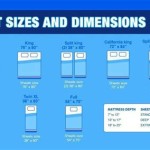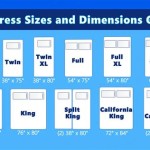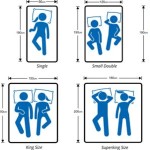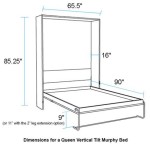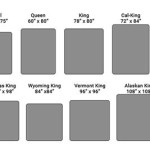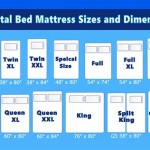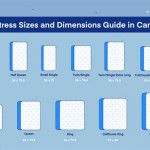How To Tell What Size Your Bed Is
Determining the size of a bed is essential for purchasing the correct bedding, finding a compatible bed frame, and planning room layouts. While the bed may appear a certain size, relying solely on visual estimation can lead to errors. Accurately identifying the bed size requires a combination of measurement and comparison to standard bed dimensions. This article provides a comprehensive guide on how to determine the size of a bed using various methods.
The most straightforward method involves measuring the bed's length and width. These measurements, once converted to inches, can be compared to standard bed size dimensions to identify the bed type. This method eliminates guesswork and provides a definitive answer.
Measuring the Bed Frame and Mattress
The first step in determining bed size is to accurately measure the bed frame and the mattress separately. Use a measuring tape, preferably one that is at least 100 inches long, to ensure you can measure the entire length and width of the bed without having to move the measuring tape. Measuring both the frame and the mattress can help to account for any discrepancies, especially if the mattress is not the original one designed for the frame.
Begin by measuring the length of the mattress. Place the end of the measuring tape at one edge of the mattress and extend it to the opposite edge, ensuring the tape is straight and taut. Record the measurement in inches. Repeat this process for the width of the mattress, measuring from one side to the other. Again, ensure the tape is straight and taut and record the measurement in inches.
Next, measure the bed frame similarly. Measure the length and width of the interior of the frame, where the mattress sits. This measurement is critical for ensuring the mattress fits properly. If the frame has protruding elements, such as a headboard or footboard, only measure the interior space designed to accommodate the mattress. Record these measurements separately.
It's crucial to take accurate measurements. Rounding to the nearest inch is generally acceptable, but avoid rounding excessively as even small differences can impact bedding and frame compatibility. If measurements are taken in centimeters, conversion to inches is necessary. Consult a reliable online converter to ensure accuracy.
Comparing Measurements to Standard Bed Sizes
Once bed frame and mattress measurements are acquired, the next step is to compare them to the standard bed sizes. Standard bed sizes are recognized throughout the bedding industry, and understanding these dimensions is key to identifying the bed type. It is important to note that slight variations can occur between manufacturers, so a measurement might not perfectly match the standard; however, close proximity usually indicates the bed size.
The most common bed sizes and their standard dimensions are as follows:
*Twin (Single):
Typically measures 38 inches wide and 75 inches long. This size is suitable for single sleepers, children, and smaller rooms. *Twin XL:
Measures 38 inches wide and 80 inches long. The extra length makes it ideal for taller individuals and is frequently found in college dormitories. *Full (Double):
Measures 53 inches wide and 75 inches long. A full-size bed offers more space than a twin and can accommodate a single adult comfortably, or two smaller individuals. *Queen:
Measures 60 inches wide and 80 inches long. The queen size is a popular choice for couples and offers ample space for individual sleepers who prefer more room. *King:
Measures 76 inches wide and 80 inches long. A king-size bed provides maximum space for couples and allows for greater freedom of movement during sleep. *California King:
Measures 72 inches wide and 84 inches long. The California king is longer but slightly narrower than a standard king, making it suitable for longer rooms and taller individuals.Compare the measured dimensions of the mattress or bed frame to these standard sizes. Identify which standard size most closely matches the measurements. For example, if the mattress measures approximately 60 inches wide and 80 inches long, it is likely a queen-size mattress. If a bed frame measures 76 inches wide and 80 inches long internally, it is designed for a king-size mattress.
If the measurements do not precisely match the standard dimensions, consider that the mattress may have compressed over time or the frame may be slightly non-standard. In these cases, match the closest dimension. If the length is exact, but the width is an inch or two off, prioritize the length measurement for determining the bed size.
It is also important to consider that European bed sizes may differ from North American standards. If the bed was purchased outside of North America, or the origin is unknown, research European bed size dimensions for a more accurate comparison.
Checking Manufacturer's Labels and Documentation
Another way to determine bed size is to identify and examine the manufacturer's labels or documentation associated with the bed or mattress. These labels often contain crucial information, including the size and model of the bed, directly provided by the manufacturer. This method can provide a definitive answer without relying on measurements or comparisons.
Begin by thoroughly inspecting the mattress. Labels are often sewn into the fabric, usually along the edge or at the foot of the mattress. Look for a tag that includes information about the manufacturer, model name, and most importantly, the size of the mattress. Words or abbreviations such as "Twin," "Full," "Queen," "King," or "Cal King" along with dimensions, such as “60 x 80,” are common indicators of size. Some manufacturers may also use pictorial representations of the bed size.
If labels are ripped or faded to the point of being unreadable, check the documentation that may have been retained from the purchase. This could include the original receipt, warranty information, or the mattress care guide. These documents often specify the size of the bed purchased. If the bed frame was purchased separately, check for labels or documentation on the bed frame itself. Similar to mattress labels, bed frame labels may be affixed to the frame structure, usually on the inside or underside.
If the bed was purchased online, checking the purchase history on the retailer's website is another viable approach. The order details usually specify the size of the bed or mattress. This can be particularly useful if the physical labels are missing or damaged.
In some cases, the manufacturer's name and a serial number may be present on the mattress, but the size isn't explicitly stated. Contacting the manufacturer directly with this information may allow them to identify the bed size based on their records. This method is particularly helpful if the bed is an older model or from a less common manufacturer.
When checking labels and documentation, be vigilant for discrepancies. Ensure that the information on the mattress label matches the information on the bed frame label and any existing documentation. If discrepancies exist, further investigation, such as measuring the bed, may be required to resolve the ambiguity.
By combining accurate measurement techniques with a comparison to standard bed sizes and a thorough examination of manufacturer's labels and documentation, determining the size of a bed becomes a straightforward process. These techniques ensure accurate identification, leading to the purchase of correctly sized bedding, frames, and accessories.

How To Measure A Mattress 7 Steps With Pictures Wikihow

Mattress Sizes Chart And Bed Dimensions Guide Amerisleep

A Guide To Choosing The Right Bed Size

How To Measure Bed Size 10 Steps With Pictures Wikihow

Bed Sheet Ing Guide Designer Living

Mattress Sizes What Size Room You Should Have Them In The Sleep Judge

Is Your Mattress The Right Size For Needs Here S How To Tell

Bed Sizes And Dimensions Choosing The Right Size Mattress
Mattress Size Chart And Bed Dimensions Guide 2024

Mattress Size Chart Know What To Look For

